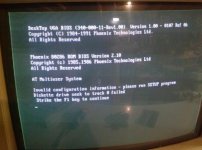Windows2000
Experienced Member
Now that I have found some time to myself I decided to work on my clones this past week and have found some success in getting them operational again, but I now have come to a snag in the road that I have been trying to work against for a good hour. So now I ask the community for their input. Attached below is exactly how far I have come to a PC Edge (Not Leading Edge) 286 AT clone.

Obviously some tweaks in the BIOS (Or as it said, setup program) are needed but the screen displays no help on how to get into the program, I've looked online and have tried several different key combinations but no luck. I've switched keyboard three times to make sure it wasn't a mechanical problem but I still get the same result. Striking F1 only replies something about a missing boot disk, even when there is a boot floppy in the drive or a hard drive connected. Then comes the diskette drive problem, as I can not have any drive connected AT ALL and it still displays a "track 0" error. For this I have tried two different 3.5" floppy drives and one 5.25" floppy drive with no chance in the results here either. I have replaced the CMOS battery already but there was no change, I have tried restarting it with no CMOS battery at all and there was no chance even when waiting for 10-15 minutes.
Basically I can't continue any further than this and I really want to get this system up and running again but I am not sure what to do with this. I cannot find any documentation on a PC Edge 286 AT either, so my assistance is very limited.

Obviously some tweaks in the BIOS (Or as it said, setup program) are needed but the screen displays no help on how to get into the program, I've looked online and have tried several different key combinations but no luck. I've switched keyboard three times to make sure it wasn't a mechanical problem but I still get the same result. Striking F1 only replies something about a missing boot disk, even when there is a boot floppy in the drive or a hard drive connected. Then comes the diskette drive problem, as I can not have any drive connected AT ALL and it still displays a "track 0" error. For this I have tried two different 3.5" floppy drives and one 5.25" floppy drive with no chance in the results here either. I have replaced the CMOS battery already but there was no change, I have tried restarting it with no CMOS battery at all and there was no chance even when waiting for 10-15 minutes.
Basically I can't continue any further than this and I really want to get this system up and running again but I am not sure what to do with this. I cannot find any documentation on a PC Edge 286 AT either, so my assistance is very limited.
